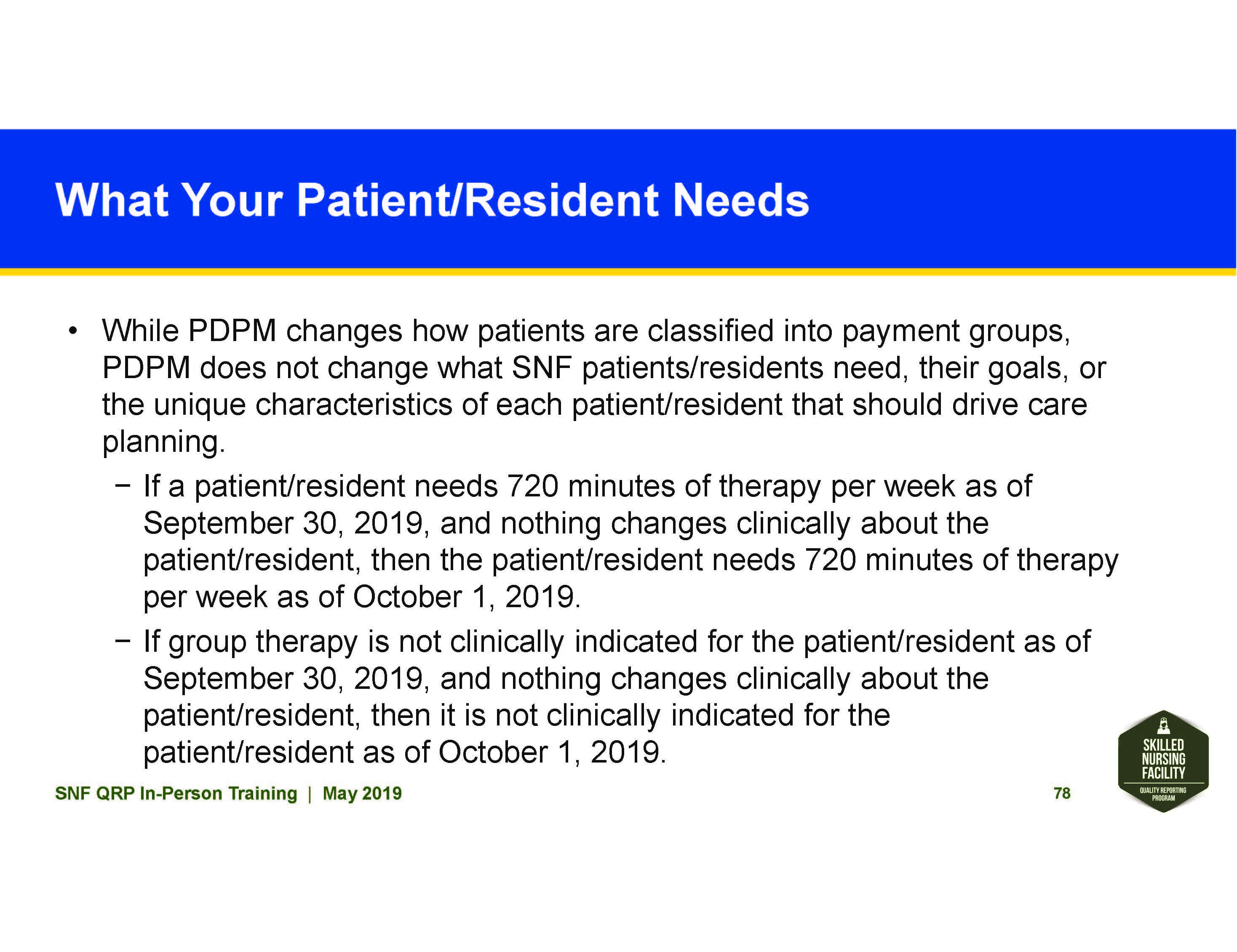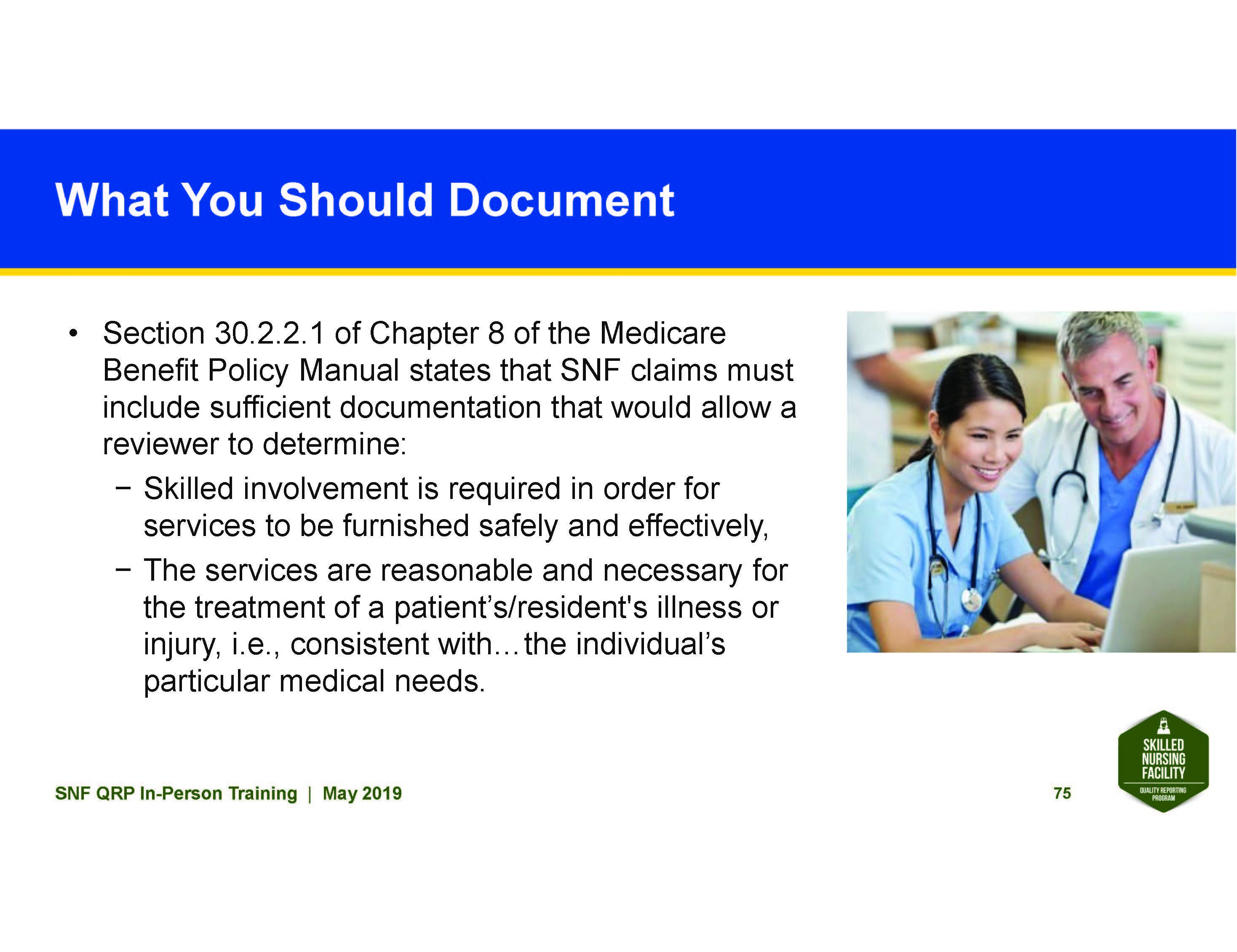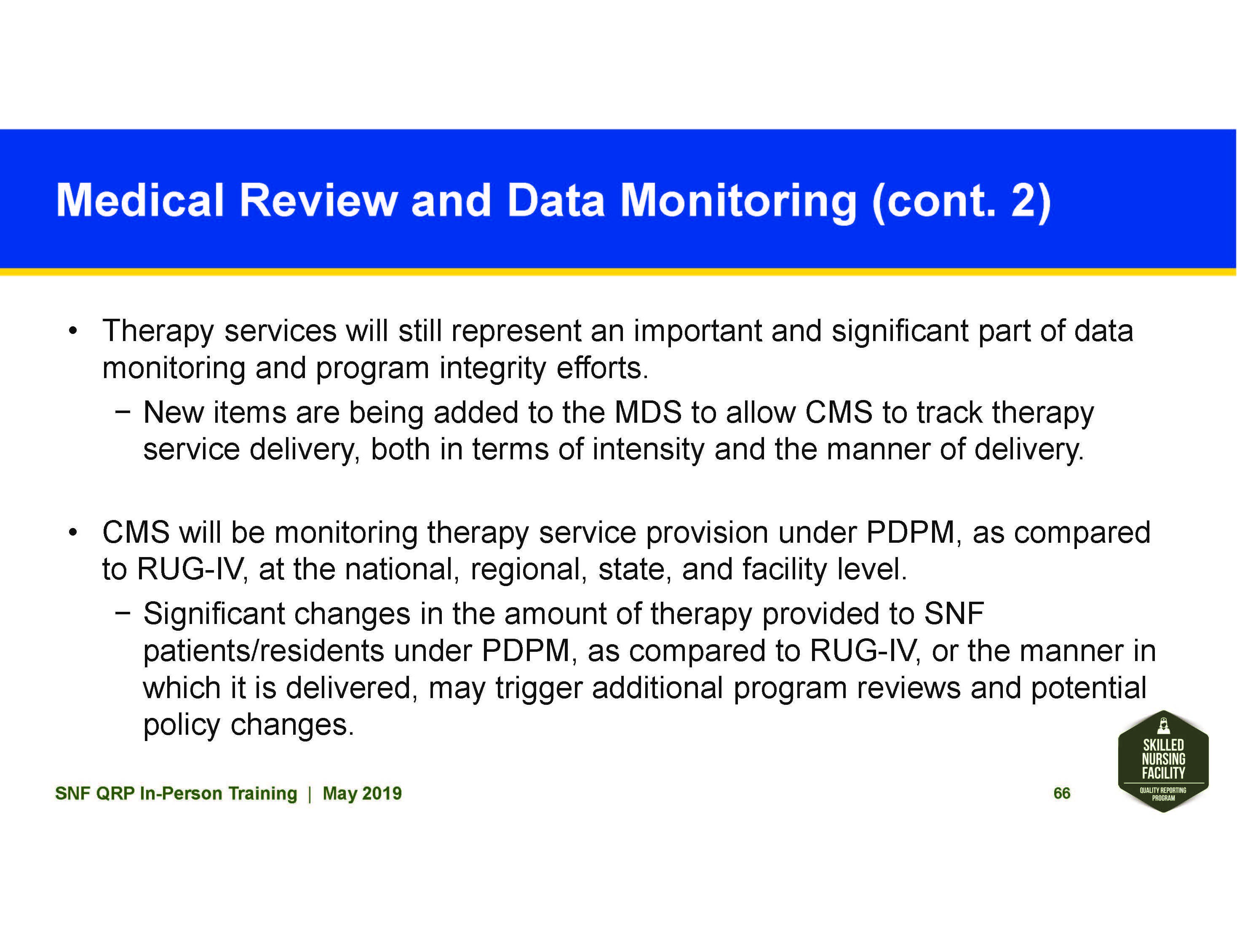
The question pertains to Medicare Part A therapy services in the SNF (Skilled Nursing Facility). The answer may seem obvious to most….though reports from concerned therapists around the country on this topic may indicate otherwise.
Well, the “official” answer to this question was provided for all on May 8th during a 2-day intense CMS Provider Training Session held in Kansas City, MO. In the Patient Driven Payment Model Training [PDPM] Session, presenter John Kane, Senior Analyst, Division of Institutional Post Acute Care, Center for Medicare, provided insight for those in attendance.
Slide 78 [see below] from the presentation by CMS is clear. As John read the slide, there was a hint of “duuuuuh” in his voice, as if though this is the obvious answer, he was aware of alternate answers and alternate plans out there to “get around” the obvious answer to this question.
So, yes…whatever is clinically appropriate for your resident on September 30th should still be clinically appropriate on October 1st, barring some coincidental significant change in clinical condition, or your residents’ new-found desire to perform therapy in a group.
With a short story and a few facts later, it became understandable as to why this slide was presented and why “the obvious” needed to be stated.
John, one of the architects of PDPM, described a meeting he attended with CMS representatives and national rehab provider groups early on when details of the PDPM were being worked out. John reported context from that meeting which may, or may not!, surprise SNF therapists.
When the rehab providers were asked, “…if CMS were to set the group therapy provision limit to 25%, how much group therapy would you provide?“….John stated that “without a moments hesitation” the answer from the rehab groups was “25%!”
Shocking? Not to some SNF therapists who are reporting their companies are already instructing them to prepare for “more group therapy.”
In that meeting, CMS also asked rehab providers, “…if the limit was 50%, how much group would be provided?”…and the answer [no drum roll needed] was “50%.”
So basically, whatever amount of rope CMS would give rehab providers, they would take it. But this may be a rope that providers potentially hang themselves with.
John stated that these were the “suspected answers” from rehab providers, though stated CMS was “hoping” rehab providers would say something different. But CMS has known for years that rehab providers adapt their practice to every regulation change, so why would this time be any different? In fact, PDPM itself is in part, a CMS response to prevent rehab provider-past-practice of “giving more to get more.”
Remember, Medicare [CMS] is the “insurance company” that represents their beneficiaries, the resident. And they want the best for their beneficiary, and the most bang for their buck, which in their opinion, is Individual Therapy. Unfortunately, what rehab providers want does not always fall in line with CMS ideals.
Resident “Need”
Here is were SNFs may shoot themselves in the foot. If on October 1st, therapy provision changes in any way…meaning:
- less minutes per day
- less days per week
- less disciplines involved
- staggering disciplines to make up 5 calendar days per week
- more group therapy
- more concurrent therapy
- decrease in duration of therapy episode
…then what the provider, is essentially saying is that what was provided PRIOR to October 1st was NOT “reasonable and necessary.” We all know that Chapter 8 of the Medicare Benefit Policy Manual outlines the regulatory criteria for SNF Part A services, and we know that the basis of coverage for therapy is “reasonable and necessary in amount, frequency and duration.”
Just in case, John reminded providers of this on Slide 75 of the CMS presentation [see below].
 So essentially, decreasing therapy services or changing practice patterns after October 1st could be a red flag to indicate that the services you provided prior to October 1st were inflated, and thus “unreasonable and unnecessary”.…and you could be opening yourself up for review and $$$ take-back.
So essentially, decreasing therapy services or changing practice patterns after October 1st could be a red flag to indicate that the services you provided prior to October 1st were inflated, and thus “unreasonable and unnecessary”.…and you could be opening yourself up for review and $$$ take-back.
Remember the False Claims Act lawsuit outcomes over the past 10 years and what they have alluded to? In those lawsuits, if negative practice patterns were used to increase therapy solely to attain a higher Rehab RUG, the billing claims submitted were deemed “false” and fraudulent.
So what’s to say that a SNF’s claims from prior to October 1st can’t be reviewed and deemed “unreasonable and unnecessary” based on changes your SNF makes after October 1st?
Need a False Claims Act lawsuit refresher? See this article
Monitoring for Change
CMS has compliance monitoring measures in place, and from the sounds of it in the presentation, there are measures in place in addition to the ones we are currently aware of. We know that the PPS Discharge MDS will collect all the data from therapy, including amount and mode, and will calculate if the 25% limit on non-individual therapy was triggered. The Validation Report will provide a warning, not only to the SNF when the MDS is submitted to CMS, but to CMS [yes, they monitor these!] if the limit was exceeded. In his presentation, John emphatically stated that “if this pops up a lot, it WILL trigger something” [on CMS’s end]. If you are an Administrator, particularly in a SNF that uses a contract rehab company, I would assign your MDS Coordinator with the task of providing you with any Validation Report that triggers in this area. This is something to act on to prevent harm down the road.
It’s almost comical to think that providers are changing their practice now so that when October 1st comes around, it “won’t look like a change occurred” since practices were “already in place.” Really? Do providers realize that data with practice patterns have been submitted for the 20+ years of PPS, and that CMS is not so short sighted to only look at the last 6 months prior to October 1st?
The CMS presentation stated [see slide 66 below] that changes in facility practice patterns will be monitored at the federal level, state level, regional level, MAC level, and individual provider level! Changes that are detected may not only impact a specific facility, but will collectively be used to shape future CMS policy with PDPM…possibly a group therapy payment reduction?

Only Quality Outcomes Will Tell
CMS is fully aware of all the “rumors” out there, in particular the ones stating SNF therapists will lose their jobs in October when PDPM kicks in, as well as those that indicate therapy is “less important” under PDPM. John made the comment that talk like this was one of the things that “irked” him – which should give some comfort to SNF therapy professionals that CMS is really on your side.
CMS is, however, acknowledging that therapy provision will likely change as a result of PDPM…rehab providers will take some of that rope and use it… and there is nothing they can do to prevent that. But after the initial shock of October 1st subsides, and some adjustments are made, CMS is looking for a balance…and the bottom line they are looking at is this:
If the facility Quality Measures are impacted by a reduction in therapy services…there will be trouble.
If Quality Outcomes suffer {meaning the resident suffers} as a result of less therapy in general or less individual therapy, the facility will be held responsible. Are your residents triggering for “more pain,” or “new or worsening pressure ulcers,” or more falls… the list goes on.
What SNF therapists can do individually and collectively, is ensure that each resident is thoroughly evaluated and that the evaluation plan of care outlines the specific amount, frequency and duration that the resident would benefit from. Decisions to include Concurrent and/or Group Therapy in every resident’s plan of care “just in case” will not cut it with CMS. And if Group is done, the documentation to support its “reasonable and necessary” qualities for each individual resident will be needed.
Do not allow anyone other than the clinician that laid eyes on, evaluated and/or knows the clinical needs of the resident, to direct the type of therapy needed. Yes, some residents may need less therapy after October[because the therapy they were receiving prior to October 1st was over-inflated.] But some residents may need more therapy than you will be “allowed” to provide. The evaluating and treating therapists, should be the sole persons involved in determining what mode of therapy is best for each RESIDENT. Advocating and documenting each resident’s clinical need is in your hands!
And guess what? CMS will back you up!
Link to John’s full presentation slides
If you have any questions, send them to our Just Ask Q&A Forum and we will respond to you individually.
In Your Corner,
Dolores
Dolores Montero, PT, DPT, RAC-CTA
SNF Therapy & MDS Compliance
